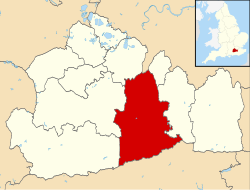Parish history
The right to appoint the vicar belonged with the manor to the Prior and Convent of Christ Church, Canterbury Cathedral from at least 1231 to 1527. A vicarage instead of a rectory was ordained by the monks before 1308–9 who would thereafter fund that position in exchange for direct receipt of all the rectorial land and the greater and lesser tithes of the rest of the parish. After the loss of Christchurch under Henry VIII's reforms, [8] the rectory resumed and the right to name the rector transferred to Sir Robert Southwell with the manor, as in 1547 he transferred both to Henry Lechford, whose son Sir Richard conveyed the right to Richard Dallender in 1609. In 1615 Dallender quitclaimed to Robert Hatton, from whom in 1622 it returned to the Lechfords. Sir Richard Lechford, when he sold the manor of Charlwood in 1625, retained the right, selling it, however, in 1629 to Edmund Sander of Charlwood Place, by then a far taller, more grandiose manor in the parish. [7]
In 1644 the Bishop was compelled to sequester the priest position to a new rector, the previous incumbent, Thomas Mulcaster, having been proceeded against by 'five or six of the very scum of the parish,' according to his own account. This was during one of the most visible phases of the European wars of religion in England, the Civil War. [7]
His son-in-law, Henry Hesketh, chaplain in ordinary to Charles II, was afterwards rector of Charlwood. In 1661 Edmund Sander devised all his lands and tenements here including the property of the rectory, to his sister Elizabeth Bradshaw, from whom they passed to her cousin Sir William Throckmorton, who sold in 1672 to Sir Andrew King. In 1716 the rectory and its appointment right were conveyed to Henry Wise from according to Owen Manning the trustees of Francis Aungier, 1st Earl of Longford the intermediate owner. The property remained with the Wises until 1884, during which time the church was often served by members of that family and passed to the Rev. E. M. Gibson and some time after him it vested in the diocese. [7]
- Extraterritorial diocese
In terms of its relevant see of a bishop, Charlwood was 'a peculiar of Canterbury' until 1846, when it was transferred to Winchester. By the rearrangement of dioceses in 1878 it was again transferred to Rochester and was added to Southwark on its creation. [7]



